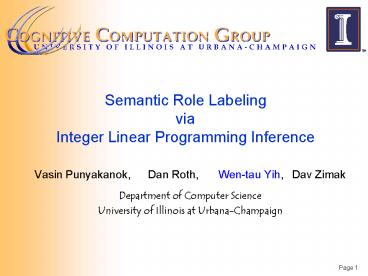Semantic Role Labeling via Integer Linear Programming Inference - PowerPoint PPT Presentation
1 / 19
Title:
Semantic Role Labeling via Integer Linear Programming Inference
Description:
Semantic parsing is an important task toward natural language understanding, and ... Their adjuncts, e.g., Locative, Temporal or Manner ... – PowerPoint PPT presentation
Number of Views:90
Avg rating:3.0/5.0
Title: Semantic Role Labeling via Integer Linear Programming Inference
1
Semantic Role Labeling via Integer Linear
Programming Inference
- Vasin Punyakanok, Dan Roth, Wen-tau Yih, Dav
Zimak - Department of Computer Science
- University of Illinois at Urbana-Champaign
2
Semantic Role Labeling
- Semantic parsing is an important task toward
natural language understanding, and has immediate
applications in Q/A. - For each verb in a sentence
- identify all constituents that fill a semantic
role - determine their roles
- Agent, Patient or Instrument,
- Their adjuncts, e.g., Locative, Temporal or
Manner - PropBank project Kingsbury Palmer02 provides
a large human-annotated corpus of semantic
verb-argument relations. - CoNLL-2004 shared task Carreras Marquez 04
- No parsed data in the input
3
Example
- A0 represents the leaver,
- A1 represents the thing left,
- A2 represents the benefactor,
- AM-LOC is an adjunct indicating the location of
the action, - V determines the verb.
4
Special Argument Types
- C-XXX (continuity)
- R-XXX (relative pronoun)
5
3-Stage Approach
- Find potential argument candidates
- Filtering most of the phrases
- Classify arguments to types
- Estimate the conditional probabilities
- Inference for Argument Structure
- Cost Function
- Constraints
- Integer linear programming (ILP)
6
I. Find Potential Arguments
- An argument can be any set of consecutive words
- Restrict potential arguments
- Classify BEGIN(word)
- BEGIN(word) 1 ? word begins argument
- Classify END(word)
- END(word) 1 ? word ends argument
- Argument
- (wi,...,wj) is a potential argument iff
- BEGIN(wi) 1 and END(wj) 1
- Reduce set of potential arguments (PotArg)
7
II. Arguments Type Likelihood
- Assign type-likelihood
- How likely is it that arg a is type t?
- For all a ? POTARG , t ? T
- P (argument a type t )
0.3 0.2 0.2 0.3
0.6 0.0 0.0 0.4
A0
C-A1
A1
Ø
8
Details Phrase-level Classifier
- Learn a classifier (SNoW)
- ARGTYPE(arg)
- ?P(arg) ? A0,A1,...,C-A0,...,AM-LOC,...
- argmaxt?A0,A1,...,C-A0,...,LOC,... wt ?P(arg)
- Estimate Probabilities
- Softmax over SNoW activations
- P(a t) exp(wt ?P(a)) / Z
9
Inference
- Maximize the expected number of correct argument
predictions - T argmaxT ? i P( ai ti )
- Subject to some constraints
- Structural and Linguistic (R-A1?A1)
I left my nice pearls to her
I left my nice pearls to her
10
Problem Setting
- Random Variables X
- Conditional Distributions P (learned by
classifiers) - Constraints C any Boolean function
- defined on partial assignments (possible
weights W on constraints) - Goal Find the best assignment
- The assignment that achieves the highest global
accuracy. - This is an Integer Programming Problem
z
XargmaxX P?X subject to
constraints C
11
Integer Linear Programming
- A set of binary variables, x (x1,, xd)
- A cost vector p ?Rd,
- Cost matrices C1?Rd?Rt C2?Rd?Rr,
- t, r of (inequality, equality) constraints d
- of variables. - The ILP solution x is the vector that maximizes
the cost function, - x argmax x ?0,1d p?x
- Subject to C2xgt b1 and C1x b2,
- where b1, b2?Rd and x?0,1d
12
LP Formulation Linear Cost
- Cost function
- ?a ? POTARG P(at) ?a ? POTARG , t ? T P(at)
xat - Indicator variables
- xa1A0, xa1 A1, , xa4 AM-LOC, xP4? ?
0,1 - Total Cost
- p(a1 A0) x(a1 A1) p(a1 ?) x(a1 ?)
p(a4 ?) x(a4 ?)
13
Linear Constraints (1/2)
- Binary values
- ? a ? POTARG , t ? T , xa t ? 0,1
- Unique labels
- ? a ? POTARG , ? t ? T xa t 1
- No overlapping or embedding
- a1 and a2 overlap ? xa1Ø xa2Ø ? 1
14
Linear Constraints (2/2)
- No duplicate argument classes
- ?a ? POTARG xa A0 ? 1
- R-XXX
- ? a2 ? POTARG , ?a ? POTARG xa A0 ? xa2
R-A0 - C-XXX
- a2 ? POTARG , ? (a ? POTARG) ? (a is before a2 )
xa A0 ? xa2 C-A0 - Exactly one argument of type Z (e.g, verb)
- Given a verb, no argument types will not appear.
- Any Boolean Rule can be encoded as a linear
constraint.
15
Experiments (1/2)
- Without inference, the sentence level prediction
is usually meaningless. - The key point of the experiments is to evaluate
the role of inference.
I. Given the boundaries of arguments
Development Set
16
Experiments (2/2)
II. Effects of inference on different stages
Provides better probability estimations
- Overall F1 on Test Set 66.39
- 2nd best system in the CoNLL-2004 shared task
17
Summary
- Inference Global inference helps !
- All constraints vs. only non-overlapping
constraints - error reduction gt 5 gt 1 absolute F1
- A lot of room for improvement (additional
constraints) - Easy and fast 1520 minutes
- The ILP Inference framework is also applied in
other problems. - Allows the use of soft constraints
- Possible to interleave learning and inference and
deal with interacting learning problems
18
(No Transcript)
19
Argument Types
- A0-A5 and AA have different semantics for each
verb as specified in the PropBank Frame files. - 13 types of adjuncts labeled as AM-XXX where XXX
specifies the adjunct type. - C-XXX is used to specify the continuity of the
argument XXX. - In some cases, the actual agent is labeled as the
appropriate argument type, XXX, while the
relative pronoun is instead labeled as R-XXX.































